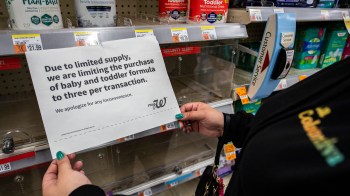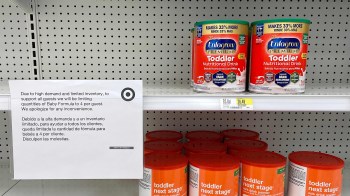Food makers hungry to change for WIC
TEXT OF STORY
Kai Ryssdal: The federal government has been subsidizing food for low-income mothers and their children for more than 30 years. The choices in the WIC program — that stands for Women, Infants and Children — have been pretty limited traditionally. Mostly dairy products and baby formula. That is going to change on Thursday though.
Mothers will be able to use their vouchers for fresh produce and other healthier things like soy milk and brown rice too. All told WIC accounts for about $4.5 billion in retail food sales every year. And that has food makers hungry enough to make some big changes as Rachel Dornhelm reports.
RACHEL DORNHELM: Fresh loaves of bread move down the line at Sara Lee’s bakery in Denver. The 20-ounce loaves disappear into a giant silver slicer. As they emerge, a blast of air blows off the crumbs before they’re slipped into bags. All the usuals are here: white, whole grain, wheat. And something new: a 16-ounce loaf made especially for one customer.
HEATHER COLLINS: We first heard about the new WIC guidelines about a year-and-a-half ago. It was absolutely good news.
That’s Heather Collins, a director of marketing at Sara Lee. The good news was the USDA was adding bread to the nutrition program. WIC’s vouchers are issued for very specific foods, in specific amounts. In the past, that was mostly milk, eggs, cheese, juice and infant formula. Now there’s more variety, but with conditions. WIC certified bread, for example, has to have over 51 percent whole grains, and it needs to come in a one-pound package.
COLLINS: So with that we started working with R&D to formulate a product that would and could be utilized to meet the 51 percent requirement.
Turns out it’s not like baking at home where you might just toss in some extra whole wheat. They have to consider…
COLLINS: Sugar levels, sodium levels, yeast levels, gluten levels…
And those weren’t the only considerations.
COLLINS: We needed to invest in 16-ounce pans because normally the marketplace is in a 20-ounce pan, so there was an investment on our part in order to again fulfill that requirement.
Collins says Sara Lee spent several hundred thousand dollars on the pans alone. But she says it’s worth it. Tortillas have also been added to the new WIC menu.
Jim Kabbani is executive director of the Tortilla Industry Association. He estimates that if just 10 percent of WIC customers buy tortillas with their vouchers, that could mean $2 million a month in sales.
JIM KABBANI: You’re looking at somewhere in the neighborhood of 800,000 consumers added to the pipeline of our producer members.
But again, it’s not that simple. Tortillas are generally sold by count — 20 tortillas, 50 tortillas. The nutrition guidelines were scientifically determined by weight. Making packages conform could be hard for smaller tortilla makers, Kabbani says.
KABBANI: They would have to retool, resize the tortillas, which is a little bit culturally not a good fit, or make them thinner or make them thicker.
Same story for the soy foods industry — the nutritional makeup for WIC approved soy milk didn’t match existing offerings. So, again new products had to be developed. At this point you may be wondering why the WIC program didn’t draw its specifications to meet products already on the market. Politics. To keep the food lobbies from trying to influence the product list, Laurie True, executive director of the California WIC Association, says the nutrition guidelines were drawn up by the Institute of Medicine, or IOM.
LAURIE TRUE: The decision making which was very, very critical policy making was really commissioned by the USDA to keep it out of the lobbying and commodity pressure realm that’s so prevalent in Congress.
Kevin Concannon, undersecretary for food, nutrition and consumer services at the department, says the agency held hearings on the changes and worked with food manufacturers. He says some of them may have been particularly interested because of the recession.
KEVIN CONCANNON: In this economy in particular, I think manufacturers, processors, retailers,they don’t want to readily concede a market or say we’re not going there.
Concannon says the downturn may makes manufacturing and selling WIC products more attractive because demand is practically built in. And it’s growing. More than half the babies born each year in the U.S. are enrolled in a WIC program.
I’m Rachel Dornhelm for Marketplace.
There’s a lot happening in the world. Through it all, Marketplace is here for you.
You rely on Marketplace to break down the world’s events and tell you how it affects you in a fact-based, approachable way. We rely on your financial support to keep making that possible.
Your donation today powers the independent journalism that you rely on. For just $5/month, you can help sustain Marketplace so we can keep reporting on the things that matter to you.


















